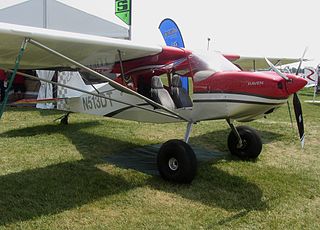
The Cirrus SR20 is an American piston-engined, four- or five-seat composite monoplane built since 1999 by Cirrus Aircraft of Duluth, Minnesota. The aircraft is the company's earliest type-certified model, earning certification in 1998.

The Cessna 162 Skycatcher is an American side-by-side two-seat, high-wing, strut-braced, tricycle gear light-sport aircraft (LSA) that was designed and produced by Cessna between December 2009 and December 2013. Its intended market was flight training and personal use.

The Van's RV-12 is an American two-seat, single-engine, low-wing homebuilt airplane eligible for the U.S. E-LSA category, sold in kit form and as a complete ready-to-fly aircraft by Van's Aircraft of Aurora, Oregon.

The CSA SportCruiser is a two-seat, single engine, tricycle undercarriage, fixed-wing aircraft that was introduced in 2006 by Czech Aircraft Works (CZAW), now named Czech Sport Aircraft.

The Cirrus Vision SF50, also known as the Vision Jet, is a single-engine very light jet designed and produced by Cirrus Aircraft of Duluth, Minnesota, United States.

Glasair Aviation USA, LLC is a Chinese-owned aircraft manufacturer based in Arlington, Washington that produces the Glasair and Sportsman 2+2 line of homebuilt aircraft. More than 3000 Glasair kits have been delivered worldwide.

The ICON A5 is an American amphibious light-sport aircraft (LSA) designed and produced by ICON Aircraft. A concept aircraft was first flown in 2008, and creation of the production tooling began in December 2012. The first production aircraft made its first flight on July 7, 2014, and made its public debut at EAA AirVenture Oshkosh on July 27, 2014. A year later at AirVenture, it was temporarily donated to the youth group Young Eagles, with the first official A5 customer deliveries occurring in 2016. As of 2019, 100 A5s had been delivered. The aircraft is known for having brought significant excitement and publicity to the LSA industry since its unveiling in 2008, although company legal and financial issues have slowed production since 2016.

The Pipistrel Virus is a two-seat, single engine light aircraft, manufactured by Pipistrel in Slovenia and Italy, and sold as an ultralight, homebuilt kit, or light-sport aircraft.

The American Legend AL3C-100 and American Legend AL11C-100 are new design American light-sport aircraft inspired by the Piper J-3 Cub and Super Cub.

The BRM Aero Bristell NG 5, now called the Bristell Classic, is a Czech low-wing, two-seat in side-by-side configuration, single engine in tractor configuration, ultralight and light-sport aircraft that was designed by Milan Bristela and is produced by BRM Aero. The aircraft is supplied as a complete ready-to-fly aircraft.

The Pipistrel Alpha Trainer is a Slovenian two-seat, single-engine light-sport aircraft intended specifically for flight training, designed and produced by Pipistrel in Gorizia, Italy.

The Sam Aircraft Sam LS is a Canadian aircraft design, designed and produced by Sam Aircraft, formerly known as Haim Aviation of Lachute, Quebec. The aircraft was designed for the Canadian AULA and American light-sport aircraft rules and had its first flight on 26 February 2013.
Superior Air Parts, Inc. is a Chinese-owned manufacturer of aviation piston engine replacement parts, headquartered in Coppell, Texas, United States. The company has been owned by Superior Aviation Beijing since 2010.

The Samson Switchblade is an American amateur-built roadable aircraft, under development by Samson Motorworks of Meadow Vista, California. It was publicly introduced at AirVenture in 2009 in mock-up form. The aircraft is intended to be supplied as a kit for amateur construction initially and possibly as a complete ready-to-fly-aircraft in the future.

The Rans S-20 Raven is an American homebuilt aircraft that was designed by Randy Schlitter and is produced by Rans Designs of Hays, Kansas, introduced at AirVenture in August 2013. The aircraft is supplied as a kit for amateur construction and it is anticipated that it will later be offered as a complete ready-to-fly-aircraft in the light-sport aircraft category.

The CubCrafters CC19 XCub is an American light aircraft, designed and produced by Cub Crafters of Yakima, Washington, introduced in June 2016. The aircraft is supplied complete and ready-to-fly.

The Vashon Ranger R7 is an American light-sport aircraft designed and produced by Vashon Aircraft of Woodinville, Washington. It was formally introduced at the AirVenture airshow in Oshkosh, Wisconsin, in July 2018. The aircraft is supplied as a complete ready-to-fly-aircraft.

The Sling TSi is a South African four-seat, single-engine, low-wing homebuilt aircraft sold in kit form by Sling Aircraft of Johannesburg South. It was developed from the Sling 4.
The Tecnam P-Mentor is an Italian light aircraft, intended for flight training, designed and produced by Tecnam of Casoria. It was introduced in April 2022 and is EASA CS-23 type certified in Europe.
The CubCrafters Carbon Cub UL is an American light-sport and ultralight aircraft that is under development by Cub Crafters of Yakima, Washington, introduced at the Sun 'n Fun airshow in March 2023. The aircraft is intended to be supplied as a kit for amateur construction or as a complete ready-to-fly-aircraft.
















